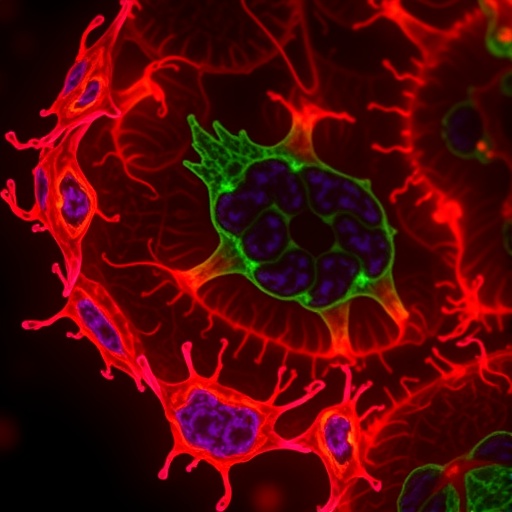In a groundbreaking study that promises to reshape the therapeutic landscape for hepatocellular carcinoma (HCC), researchers have uncovered a pivotal mechanism behind resistance to lenvatinib, one of the frontline treatments for this aggressive liver cancer. The study, recently published in BMC Cancer, reveals that the enzyme EZH2 plays a critical role in mediating drug resistance by suppressing ferroptosis, a form of regulated cell death distinct from apoptosis, through its influence on the ACSL1 pathway.
Hepatocellular carcinoma remains a leading cause of cancer-related mortality worldwide, with limited treatment options and a notorious propensity to develop resistance against current therapies. Lenvatinib, a multi-kinase inhibitor, has shown promise in extending patient survival, yet resistance emerges in a significant fraction of cases, often leading to poor clinical outcomes. The molecular underpinnings behind this resistance, however, have remained largely elusive until now.
This study delves deep into the epigenetic landscape of HCC, focusing on Enhancer of Zeste Homolog 2 (EZH2), a histone methyltransferase implicated in cancer progression and metastasis. By analyzing comprehensive data sets from The Cancer Genome Atlas (TCGA) and validating findings in clinical HCC samples via RT-qPCR, the research team identified a stark overexpression of EZH2 in tumor tissues compared to normal counterparts. Notably, this overexpression correlated strongly with diminished patient survival rates, spotlighting EZH2 as a potential prognostic marker.
To investigate the functional ramifications of EZH2 upregulation, the researchers engineered lenvatinib-resistant HCC cell lines. These models illuminated how elevated EZH2 levels suppress ferroptosis—a cell death process driven by iron-dependent lipid peroxidation and oxidative stress—thereby enabling cancer cells to evade therapeutic elimination. Central to this suppression is EZH2’s regulation of ACSL1, an enzyme critical for fatty acid metabolism and a known facilitator of ferroptosis.
Mechanistically, EZH2 exerts its effects through trimethylation of histone 3 lysine 27 (H3K27me3), a well-characterized epigenetic modification leading to transcriptional repression. The study shows that EZH2-induced H3K27me3 directly downregulates ACSL1 expression, dampening cellular oxidative stress responses that would typically culminate in ferroptotic cell death. As a consequence, HCC cells withstand lenvatinib treatment, continuing their malignant proliferation unabated.
Crucially, genetic disruption of EZH2 using targeted knockdown techniques reverses this resistance phenotype. Restoration of ACSL1 expression reactivates ferroptotic pathways, increasing levels of reactive oxygen species (ROS) and malondialdehyde (MDA), markers indicative of lipid peroxidation damage. Concurrently, glutathione (GSH) levels decrease, undermining the cellular antioxidant defenses that contribute to lenvatinib resistance.
Beyond in vitro investigations, the therapeutic viability of targeting EZH2 was confirmed in vivo through xenograft models bearing lenvatinib-resistant tumors. Treatment combining EZH2 inhibitors with lenvatinib dramatically suppressed tumor growth compared to lenvatinib alone, signifying a promising route to circumvent resistance. These results underscore the potential of combinatorial strategies aiming at epigenetic modifiers alongside kinase inhibitors in cancer therapy.
The study also highlights a novel intersection between epigenetic regulation and ferroptosis, offering new vistas for exploring similar resistance mechanisms in other malignancies. By integrating robust molecular characterization with functional assays, this research sets the stage for developing personalized interventions that may reinstate drug sensitivity in patients who relapse on standard regimens.
Importantly, the findings call attention to the EZH2-H3K27me3-ACSL1 axis as a key molecular vulnerability in HCC, providing not only mechanistic insights but also tangible biomarkers for clinical monitoring. Future clinical trials targeting EZH2 in combination with lenvatinib or other chemotherapeutics could revolutionize treatment protocols and improve survival rates in patients with advanced liver cancer.
This breakthrough enriches the understanding of ferroptosis’ role in oncogenesis and drug resistance, an area gaining increasing scientific interest due to its therapeutic potential. The elucidation of such epigenetic mechanisms expands the arsenal against cancer’s adaptability, aiming to counteract one of the major hurdles in long-term disease management.
The collaborative effort led by Zhang, Lin, Cai, and colleagues exemplifies the synergy between genomic data mining, molecular biology, and preclinical modeling. Their meticulous approach provides a blueprint for dissecting complex drug resistance phenomena, encouraging research communities to prioritize epigenetic targets in cancer treatment innovations.
As the clinical oncology field grapples with the challenge of overcoming resistance to targeted therapies, insights like these pave the way for more effective, durable interventions. By manipulating the epigenetic landscape to restore ferroptotic susceptibility, clinicians may soon curtail the relentless progression of HCC, offering hope to thousands of patients worldwide.
In summary, this study identifies EZH2 as a master regulator steering lenvatinib resistance in hepatocellular carcinoma by epigenetically silencing ACSL1 and inhibiting ferroptosis. Its comprehensive analysis from gene expression profiles to therapeutic validation positions the EZH2-H3K27me3-ACSL1 axis at the forefront of future therapeutic strategies aimed at overcoming drug resistance and enhancing patient outcomes in liver cancer.
Subject of Research: The study investigates the molecular mechanisms underpinning lenvatinib resistance in hepatocellular carcinoma, focusing on the role of EZH2-mediated epigenetic regulation and its impact on ferroptosis via ACSL1.
Article Title: EZH2 confers lenvatinib resistance in hepatocellular carcinoma by suppressing ACSL1-Mediated ferroptosis.
Article References: Zhang, Y., Lin, Y., Cai, H. et al. EZH2 confers lenvatinib resistance in hepatocellular carcinoma by suppressing ACSL1-Mediated ferroptosis. BMC Cancer 25, 1638 (2025). https://doi.org/10.1186/s12885-025-15086-9
Image Credits: Scienmag.com
DOI: https://doi.org/10.1186/s12885-025-15086-9
Tags: ACSL1 pathway involvement in drug resistanceBMC Cancer study findingscancer mortality and treatment optionsclinical outcomes in hepatocellular carcinomaepigenetic regulation in HCCEZH2 role in cancer resistanceferroptosis in liver cancerhepatocellular carcinoma treatment challengeshistone methyltransferase in cancerlenvatinib resistance mechanismsmulti-kinase inhibitors in liver cancertherapeutic implications of EZH2





